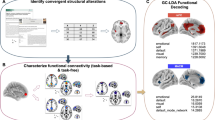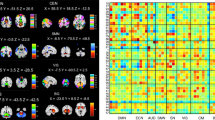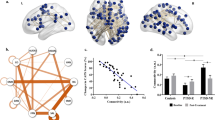Abstract
Post-traumatic stress disorder (PTSD) is associated with alterations in regional brain activation and remote functional connectivity (FC) in limbic and prefrontal cortex. However, little is known about local FC changes following a traumatic event. Resting-state functional magnetic resonance images were collected for typhoon survivors with (n = 27) and without PTSD (n = 33), and healthy controls (n = 30). Local FC was examined by calculating regional homogeneity (ReHo), and remote FC was investigated between regions showing significant ReHo group differences. The PTSD group showed ReHo changes in multiple regions, including the amygdala, parahippocampal gyrus, and prefrontal cortex relative to both control groups. Compared with healthy controls, typhoon survivors had increased ReHo in the insula/inferior frontal gyrus, middle and dorsal anterior cingulate cortex (MCC/dACC), as well as enhanced negative FC between the MCC/dACC and posterior cingulate cortex (PCC)/precuneus. The typhoon-exposed control group exhibited higher ReHo in the PCC/precuneus than the PTSD and healthy control groups. Furthermore, positive correlations were found between PTSD symptom severity and ReHo in several regions. Post-traumatic stress can influence local and remote FC, irrespective of PTSD diagnosis. Future studies are needed to validate the findings and to determine whether the alterations represent pre-existing or acquired deficits.




Similar content being viewed by others
References
American Psychiatric Association (2013). DSM-V, Diagnostic and Statistical Manual of Mental Disorders (5th ed.). Arlington, VA: American Psychiatric Publishing Inc..
Biswal, B. B., Mennes, M., Zuo, X.-N., Gohel, S., Kelly, C., Smith, S. M., et al. (2010). Toward discovery science of human brain function. Proceedings of the National Academy of Sciences, 107(10), 4734–4739.
Bluhm, R. L., Williamson, P. C., Osuch, E. A., Frewen, P. A., Stevens, T. K., Boksman, K., et al. (2009). Alterations in default network connectivity in posttraumatic stress disorder related to early-life trauma. Journal of Psychiatry & Neuroscience, 34(3), 187–194.
Boccia, M., D’Amico, S., Bianchini, F., Marano, A., Giannini, A. M., & Piccardi, L. (2015). Different neural modifications underpin PTSD after different traumatic events: an fMRI meta-analytic study. Brain Imaging and Behavior. doi:10.1007/s11682–015–9387-3.
Bremner, J. D. (2007). Neuroimaging in posttraumatic stress disorder and other stress-related disorders. Neuroimaging Clinics of North America, 17(4), 523–538, ix, doi:10.1016/j.nic.2007.07.003.
Daniels, J. K., McFarlane, A. C., Bluhm, R. L., Moores, K. A., Clark, C. R., Shaw, M. E., et al. (2010). Switching between executive and default mode networks in posttraumatic stress disorder: alterations in functional connectivity. Journal of Psychiatry & Neuroscience, 35(4), 258–266.
Druss, B. G., Hwang, I., Petukhova, M., Sampson, N. A., Wang, P. S., & Kessler, R. C. (2009). Impairment in role functioning in mental and chronic medical disorders in the United States: results from the National Comorbidity Survey Replication. Molecular Psychiatry, 14(7), 728–737. doi:10.1038/mp.2008.13.
First, M., Spitzer, R., Gibbons, M., & Williams, J. (1995). Structured clinical interview for DSM-IV. New York: Biometrics Research Department, New York State Psychiatric Institute.
Fornito, A., Yoon, J., Zalesky, A., Bullmore, E. T., & Carter, C. S. (2011). General and specific functional connectivity disturbances in first-episode schizophrenia during cognitive control performance. Biological Psychiatry, 70(1), 64–72. doi:10.1016/j.biopsych.2011.02.019.
Fox, M. D., Snyder, A. Z., Vincent, J. L., Corbetta, M., Van Essen, D. C., & Raichle, M. E. (2005). The human brain is intrinsically organized into dynamic, anticorrelated functional networks. Proceedings of the National Academy of Sciences of the United States of America, 102(27), 9673–9678. doi:10.1073/pnas.0504136102.
Hayes, J. P., Hayes, S. M., & Mikedis, A. M. (2012). Quantitative meta-analysis of neural activity in posttraumatic stress disorder. Biol Mood Anxiety Disord, 2(9), 1–13.
Hughes, K. C., & Shin, L. M. (2011). Functional neuroimaging studies of post-traumatic stress disorder. Expert Review of Neurotherapeutics, 11(2), 275–285. doi:10.1586/ern.10.198.
Jiang, L., & Zuo, X. N. (2015). Regional Homogeneity: A Multimodal, Multiscale Neuroimaging Marker of the Human Connectome. Neuroscientist, doi:10.1177/1073858415595004.
Kennis, M., Rademaker, A. R., van Rooij, S. J., Kahn, R. S., & Geuze, E. (2015). Resting state functional connectivity of the anterior cingulate cortex in veterans with and without post-traumatic stress disorder. Human Brain Mapping, 36(1), 99–109. doi:10.1002/hbm.22615.
Lanius, R. A., Frewen, P. A., Tursich, M., Jetly, R., & McKinnon, M. C. (2015). Restoring large-scale brain networks in PTSD and related disorders: a proposal for neuroscientifically-informed treatment interventions. Eur J Psychotraumatol, 6, 27313. doi:10.3402/ejpt.v6.27313.
Lee, M., Smyser, C., & Shimony, J. (2013). Resting-state fMRI: a review of methods and clinical applications. American Journal of Neuroradiology, 34(10), 1866–1872.
Liberzon, I., & Sripada, C. S. (2008). The functional neuroanatomy of PTSD: a critical review. Progress in Brain Research, 167, 151–169. doi:10.1016/s0079–6123(07)67011-3.
Patel, R., Spreng, R. N., Shin, L. M., & Girard, T. A. (2012). Neurocircuitry models of posttraumatic stress disorder and beyond: a meta-analysis of functional neuroimaging studies. Neuroscience and Biobehavioral Reviews, 36(9), 2130–2142. doi:10.1016/j.neubiorev.2012.06.003.
Pitman, R. K., Rasmusson, A. M., Koenen, K. C., Shin, L. M., Orr, S. P., Gilbertson, M. W., et al. (2012). Biological studies of post-traumatic stress disorder. Nature Reviews. Neuroscience, 13(11), 769–787. doi:10.1038/nrn3339.
Preis, M. A., Schmidt-Samoa, C., Dechent, P., & Kroener-Herwig, B. (2013). The effects of prior pain experience on neural correlates of empathy for pain: An fMRI study. Pain, 154(3), 411–418. doi:10.1016/j.pain.2012.11.014.
Sareen, J., Cox, B. J., Stein, M. B., Afifi, T. O., Fleet, C., & Asmundson, G. J. (2007). Physical and mental comorbidity, disability, and suicidal behavior associated with posttraumatic stress disorder in a large community sample. Psychosomatic Medicine, 69(3), 242–248. doi:10.1097/PSY.0b013e31803146d8.
Song, X. W., Dong, Z. Y., Long, X. Y., Li, S. F., Zuo, X. N., Zhu, C. Z., et al. (2011). REST: a toolkit for resting-state functional magnetic resonance imaging data processing. PloS One, 6(9), e25031. doi:10.1371/journal.pone.0025031.
Späti, J., Hänggi, J., Doerig, N., Ernst, J., Sambataro, F., Brakowski, J., et al. (2015). Prefrontal Thinning Affects Functional Connectivity and Regional Homogeneity of the Anterior Cingulate Cortex in Depression. Neuropsychopharmacology.
Sripada, R. K., King, A. P., Garfinkel, S. N., Wang, X., Sripada, C. S., Welsh, R. C., et al. (2012a). Altered resting-state amygdala functional connectivity in men with posttraumatic stress disorder. Journal of Psychiatry & Neuroscience, 37(4), 241–249, doi:10.1503/jpn.110069.
Sripada, R. K., King, A. P., Welsh, R. C., Garfinkel, S. N., Wang, X., Sripada, C. S., et al. (2012b). Neural dysregulation in posttraumatic stress disorder: evidence for disrupted equilibrium between salience and default mode brain networks. Psychosomatic Medicine, 74(9), 904–911. doi:10.1097/PSY.0b013e318273bf33.
Stark, E. A., Parsons, C. E., Van Hartevelt, T. J., Charquero-Ballester, M., McManners, H., Ehlers, A., et al. (2015). Post-traumatic stress influences the brain even in the absence of symptoms: a systematic, quantitative meta-analysis of neuroimaging studies. Neuroscience and Biobehavioral Reviews, 56, 207–221. doi:10.1016/j.neubiorev.2015.07.007.
van Wingen, G. A., Geuze, E., Vermetten, E., & Fernandez, G. (2011). Perceived threat predicts the neural sequelae of combat stress. Molecular Psychiatry, 16(6), 664–671. doi:10.1038/mp.2010.132.
Weathers, F., Litz, B., Herman, D., Huska, J., & Keane, T. (1994). The PTSD checklist-civilian version (PCL-C). Boston, MA: National Center for PTSD.
Weathers, F. W., Keane, T. M., & Davidson, J. R. (2001). Clinician-administered PTSD scale: a review of the first ten years of research. Depression and Anxiety, 13(3), 132–156.
Yin, Y., Jin, C., Eyler, L. T., Jin, H., Hu, X., Duan, L., et al. (2012). Altered regional homogeneity in post-traumatic stress disorder: a resting-state functional magnetic resonance imaging study. Neuroscience Bulletin, 28(5), 541–549. doi:10.1007/s12264-012-1261-3.
Zang, Y., Jiang, T., Lu, Y., He, Y., & Tian, L. (2004). Regional homogeneity approach to fMRI data analysis. NeuroImage, 22(1), 394–400.
Zhang, Y., Liu, F., Chen, H., Li, M., Duan, X., & Xie, B. (2015). Intranetwork and internetwork functional connectivity alterations in post-traumatic stress disorder. Journal of Affective Disorders, 187, 114–121. doi:10.1016/j.jad.2015.08.043.
Zhong, Y., Zhang, R., Li, K., Qi, R., Zhang, Z., Huang, Q., et al. (2015). Altered cortical and subcortical local coherence in PTSD: evidence from resting-state fMRI. Acta Radiologica, 56(6), 746–753. doi:10.1177/0284185114537927.
Zung, W. W. (1965). A self-rating depression scale. Archives of General Psychiatry, 12(1), 63–70.
Zung, W. W. (1971). A rating instrument for anxiety disorders. Psychosomatics, 12(6), 371–379.
Acknowledgments
This work was supported by the National Nature Science Foundation of China [grant number 81301209, 81301155, 81460261, 81201077]; the Key science and technology project of Hainan Province [grant number ZDYF2016156]; and the Chinese Key Grant [grant number BWS11J063, 10z026].
Author information
Authors and Affiliations
Corresponding authors
Ethics declarations
The present study was in accordance with the declaration of Helsinki, and was approved by the ethics committee of People’s Hospital of Hainan Province and the Second Xiangya Hospital of Central South University. All participants provided written informed consent after a detailed description of this study.
Conflicts of interest
Jun Ke, Feng Chen, Rongfeng Qi, Qiang Xu, Yuan Zhong, Lida Chen, Jianjun Li, Li Zhang, and Guangming Lu declare that they have no conflicts of interest.
Additional information
Jun Ke, Feng Chen, Rongfeng Qi equally to this work.
Rights and permissions
About this article
Cite this article
Ke, J., Chen, F., Qi, R. et al. Post-traumatic stress influences local and remote functional connectivity: a resting-state functional magnetic resonance imaging study. Brain Imaging and Behavior 11, 1316–1325 (2017). https://doi.org/10.1007/s11682-016-9622-6
Published:
Issue Date:
DOI: https://doi.org/10.1007/s11682-016-9622-6




